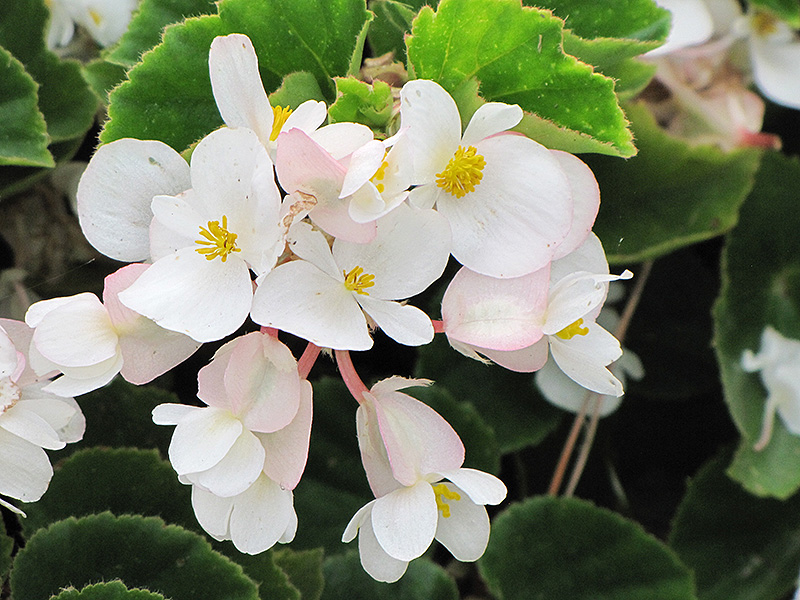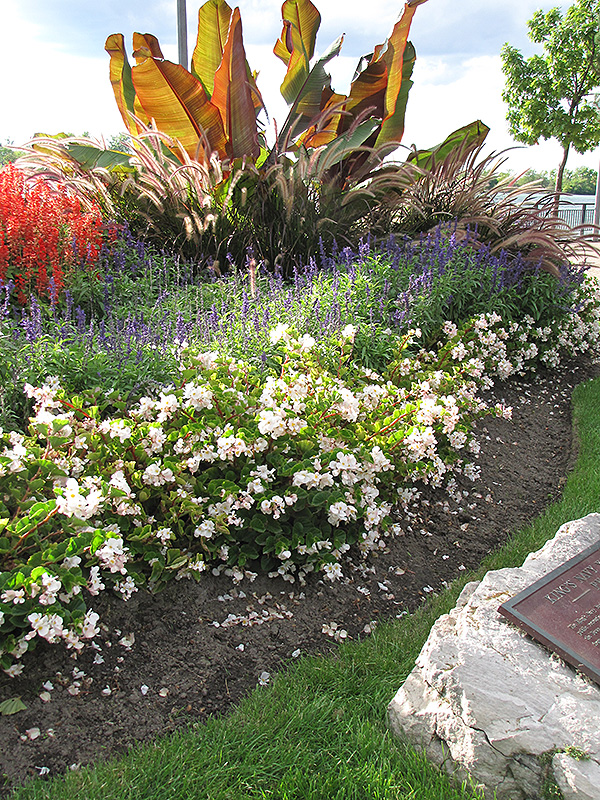Barbara Rogers Begonia
Begonia 'Barbara Rogers'
Height: 3 feet
Spacing: 20 inches
Sunlight:
![]()
Hardiness Zone: (annual)
Other Names: Semperflorens, Fibrous
Group/Class: Wax Begonia
Description:
Dark green, fan shaped foliage adorns upright stems that may grow quite tall; adorned with large white flowers from early summer to fall; attracts hummingbirds; excellent for containers and borders
Ornamental Features
Barbara Rogers Begonia features dainty white orchid-like flowers with shell pink overtones and yellow throats at the ends of the stems from early summer to mid fall. Its attractive succulent fan-shaped leaves remain dark green in color throughout the year. The brick red stems are very colorful and add to the overall interest of the plant.
Landscape Attributes
Barbara Rogers Begonia is an herbaceous annual with a mounded form. Its medium texture blends into the garden, but can always be balanced by a couple of finer or coarser plants for an effective composition.
This is a high maintenance plant that will require regular care and upkeep, and usually looks its best without pruning, although it will tolerate pruning. It is a good choice for attracting hummingbirds to your yard, but is not particularly attractive to deer who tend to leave it alone in favor of tastier treats. Gardeners should be aware of the following characteristic(s) that may warrant special consideration;
- Insects
- Disease
Barbara Rogers Begonia is recommended for the following landscape applications;
- Mass Planting
- Border Edging
- General Garden Use
- Container Planting
- Hanging Baskets
Planting & Growing
Barbara Rogers Begonia will grow to be about 3 feet tall at maturity, with a spread of 24 inches. When grown in masses or used as a bedding plant, individual plants should be spaced approximately 20 inches apart. Its foliage tends to remain dense right to the ground, not requiring facer plants in front. Although it's not a true annual, this plant can be expected to behave as an annual in our climate if left outdoors over the winter, usually needing replacement the following year. As such, gardeners should take into consideration that it will perform differently than it would in its native habitat.
This plant should be grown in a location with partial shade. Keep it away from hot, dry locations that receive direct afternoon sun or which get reflected sunlight, such as against the south side of a white wall. It requires an evenly moist well-drained soil for optimal growth, but will die in standing water. It may require supplemental watering during periods of drought or extended heat. It is not particular as to soil pH, but grows best in rich soils. It is somewhat tolerant of urban pollution, and will benefit from being planted in a relatively sheltered location. Consider applying a thick mulch around the root zone over the growing season to conserve soil moisture. This particular variety is an interspecific hybrid. It can be propagated by cuttings; however, as a cultivated variety, be aware that it may be subject to certain restrictions or prohibitions on propagation.
Barbara Rogers Begonia is a fine choice for the garden, but it is also a good selection for planting in outdoor containers and hanging baskets. Because of its height, it is often used as a 'thriller' in the 'spiller-thriller-filler' container combination; plant it near the center of the pot, surrounded by smaller plants and those that spill over the edges. It is even sizeable enough that it can be grown alone in a suitable container. Note that when growing plants in outdoor containers and baskets, they may require more frequent waterings than they would in the yard or garden.


